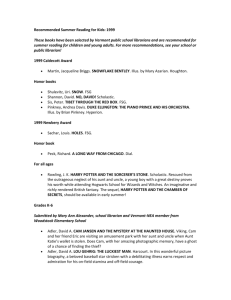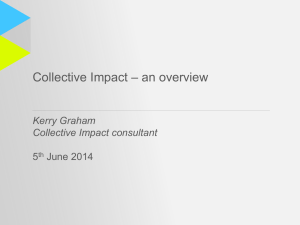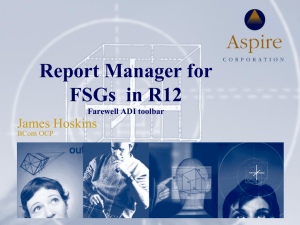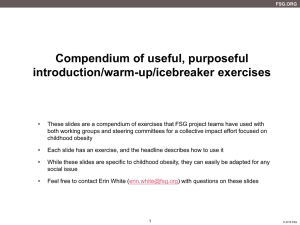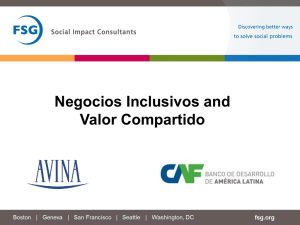Steering Committee - National League of Cities
advertisement
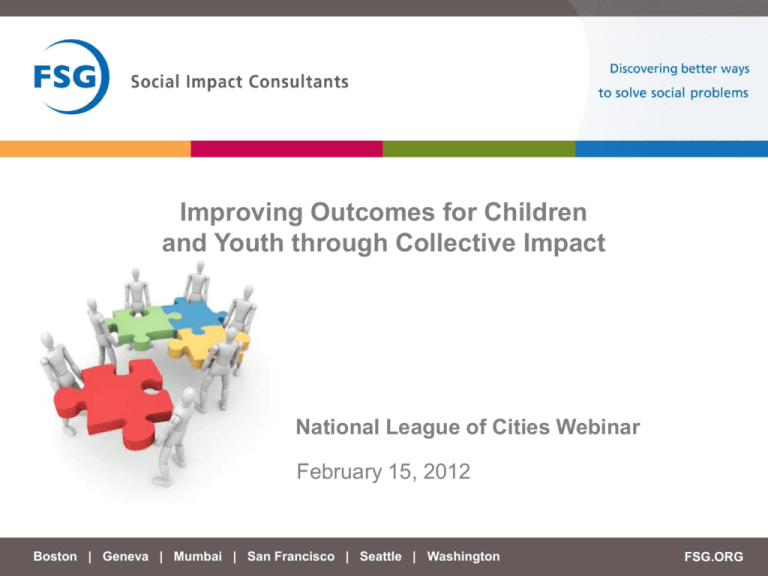
Improving Outcomes for Children and Youth through Collective Impact National League of Cities Webinar February 15, 2012 Boston | Geneva | Mumbai | San Francisco | Seattle | Washington FSG.ORG FSG.ORG Today’s Webinar Concepts and Elements of Collective Impact Examples from NLC Members Questions and Answers 2 © 2011 FSG FSG.ORG FSG and NLC Presenters • Jeff Kutash, Managing Director, Head of Education & Youth Practice, FSG • Emily Gorin, Senior Consultant, FSG • Douglas Scarboro, Executive Director, Office of Talent and Human Capital and Education Liaison to the Mayor, City of Memphis, TN • Sid Sidorowicz, Strategic Advisor, Office for Education, City of Seattle, WA 3 © 2011 FSG FSG.ORG FSG Overview • Nonprofit consulting firm specializing in strategy, evaluation and research with offices in Boston, Seattle, San Francisco, DC, Geneva, and Mumbai • Partner with foundations, corporations, nonprofits, and governments to develop more effective solutions to the world’s most challenging issues • Recognized thought leader in social impact, philanthropy and corporate social responsibility • Staff of 95 full-time professionals with passion and experience to solve social problems • Advancing Collective Impact via publications, conferences, speaking engagements, client projects 4 © 2011 FSG FSG.ORG Juvenile Justice in New York $286,000 = 89% recidivism rate 5 © 2011 FSG FSG.ORG Actors In the New York Juvenile Justice System Source: FSG interviews and analysis; State of NY Juvenile Justice Advisory Group, “State of NY, 2009–2011: 6 Three-Year Comprehensive State Plan for the JJ and Delinquency Prevention Formula Grant Program.” 6 © 2011 FSG FSG.ORG There Are Several Types of Problems Simple Complicated Complex Baking a Cake Sending a Rocket to the Moon Rehabilitating a Youth Social sector treats problems as simple or complicated Source: Adapted from “Getting to Maybe” 7 © 2011 FSG FSG.ORG Traditional Approaches Not Solving Our Toughest – Often Complex – Challenges • Funders select individual grantees • Organizations work separately and compete • Evaluation attempts to isolate a particular organization’s impact Isolated Impact • Large scale change is assumed to depend on scaling organizations • Corporate and government sectors are often disconnected from foundations and nonprofits 8 © 2011 FSG FSG.ORG Imagine a Different Approach – Multiple Players Working Together to Solve Complex Issues • All working toward the same goal and measuring the same things • Cross-sector alignment with government, nonprofit, philanthropic and corporate sectors as partners • Organizations actively coordinating their action and sharing lessons learned Isolated Impact Collective Impact 9 © 2011 FSG FSG.ORG Achieving Large-Scale Change through Collective Impact Involves Five Key Elements Common Agenda • Common understanding of the problem • Shared vision for change Shared Measurement • Collecting data and measuring results • Focus on performance management • Shared accountability Mutually Reinforcing Activities • Differentiated approaches • Willingness to adapt individual activities • Coordination through joint plan of action Continuous Communication • Consistent and open communication • Focus on building trust Backbone Support • Separate organization(s) with staff • Resources and skills to convene and coordinate participating organizations Source: Channeling Change: Making Collective Impact Work, 2012; FSG Interviews 10 © 2011 FSG FSG.ORG The Collective Impact Approach Can Apply to Solving Many Complex Social Issues Education Healthcare Homelessness Economic Development Community Development * Youth Development * * * 11 © 2011 FSG FSG.ORG A Champion, Funding, and Urgency for Change Are All Key to Launching a Collective Impact Initiative Influential Champion • Commands respect and engages cross-sector leaders • Focused on solving problem but allows participants to figure out answers for themselves Financial Resources $ • Committed funding partners • Sustained funding for at least 2-3 years • Pays for needed infrastructure and planning Urgency for Change • • • • Critical problem in the community Frustration with existing approaches Multiple actors calling for change Engaged funders and policy makers Source: Channeling Change: Making Collective Impact Work, 2012; FSG Interviews 12 © 2011 FSG FSG.ORG Collective Impact Efforts Tend to Develop Over Three Key Phases Phase I Initiate Action Phase II Organize for Impact Governance & Infrastructure Develop group; structure communication and decision making Create infrastructure/ backbone and processes Facilitate and refine Strategic Planning Map the landscape and use data to make case Create common agenda (common goals, strategy) Support implementation; alignment to goal/strategies Community Involvement Facilitate community outreach Engage community, build public will Continue engagement, conduct advocacy Evaluation & Improvement Analyze baseline data to ID key issues and gaps Establish shared metrics, indicators, measurement approach Collect/track/report progress; process to learn and improve Components for Success Source: Channeling Change: Making Collective Impact Work, 2012; FSG Interviews 13 Phase III Sustain Action and Impact © 2011 FSG FSG.ORG Backbone Organizations Require a Unique SkillSet to Support Collective Impact Efforts Highlights of Successful Backbones • Have high credibility • Seen as neutral convener • Have dedicated staff • Build key relationships • Frame issues • Create a sense of urgency • Promote learning • Balance inclusivity vs. expediency 14 skills can exist within a single organization or within another organization in the effort.© 2011 FSG *These FSG.ORG Successful Backbone Organizations Tend to Manage Six Key Functions Function Strategic Coherence Description Data Management Facilitation Communica- tions Oversee strategic direction Analyze landscape, identify gaps Collect, house, analyze, and disseminate data Manage process of defining and refining common indicators Manage meetings and logistics Act as neutral arbiter between players, as necessary Identify communication strategy to reach stakeholders Manage frequency, content, and delivery of messages Community Outreach Support meaningful cross-sector community engagement Help develop policy agenda and coordinate advocacy Funding Coordinate grant writing among initiative partners Seek and manage new grants Possible: Re-grant, serve as fiscal agent 15 © 2011 FSG FSG.ORG Many Types of Organizations Can Serve as Backbones Types of Backbones Examples Funders New Nonprofit Existing Nonprofit Government Agency or School District Shared Across Multiple Organizations Steering Committee 16 © 2011 FSG FSG.ORG Strive Is an Education Collaborative in Cincinnati That Is a Best-in-Class Example of Collective Impact 1 2 Common Agenda Shared Measurement • Programs working on the same activity measure results on the same criteria • Vision: Improving educational outcomes for all children in the Cincinnati, Northern Kentucky region from “cradle to career” 3 Mutually Reinforcing Activities • 300 organizations work on 5 key points in the education pipeline • Use evidencebased strategies 4 • Use Six Sigma to improve performance across organizations Continuous Communication • Networks have met regularly for more than five years • Use web-based tools, such as Google Groups 17 5 Backbone Support Organization • Strive is an independent nonprofit: 8 staff, $1.5M annual budget • Strive supports technology, facilitation and communications © 2011 FSG FSG.ORG The New York Juvenile Justice System Uses Collective Impact to Improve Public Safety and Youth Outcomes 1 2 Common Agenda Shared Measurement • Key system-wide outcomes tracked across organizations, specific indicators by strategy • Aggregate, system-wide data and outcomes made public • Vision: Improving public safety and youth outcomes in communities across the state 3 Mutually Reinforcing Activities • Developed strategies and action steps for system governance/coordination, service continuum, shared data, accountability • Prioritize activities to pursue in the near-term 4 Continuous Communication • Routine updates to and from state and local actors • Regular meetings of steering group and work groups 18 5 Backbone Support Organization • Strategic Planning Action Committee (SPAC) and supporting staff oversee implementation • Workgroups launched in data use and continuum © 2011 FSG Appendix FSG.ORG The Community Center for Education Results Is Also Pursuing a Collective Impact Approach to Education in Seattle Collective Impact Need Unacceptable achievement gaps for low income students and children of color, as well as low achievement rates from cradle to college and career in South Seattle and South King County Solution and Goal “Road Map Project”: new initiative aimed at dramatic improvement in student achievement – cradle through college/career in South Seattle, South King County Goal: “to double the number of students in South King County and South Seattle on track to graduate from college or earn career credential by 2020 Implementation Working groups are coordinating action in 4 areas (10-12 cross sector people per group): • Early learning • Kindergarten to 12th grade • Post secondary success • Community Support Shared set of indicators measuring progress towards: (1) healthy and ready for Kindergarten, (2) supported and successful in school, (3) graduate from high school --college and career-ready, (4) earn a college degree or career credential Backbone(s) The Community Center for Education Results is the “backbone” organization for this effort, providing dedicated staff to support the initiative 19 © 2011 FSG Appendix FSG.ORG The Roadmap Participants Have Agreed on One Framework and One Set of Success Measures Readiness Healthy and ready for Kindergarten • % children meeting kindergarten readiness standards • % children accessing comprehensive medical and dental care • % eligible children enrolled in evidencebased early learning programs Achievement Attainment Graduate from high school -college and career-ready Supported and successful in school • % students proficient in 3rd • % students graduating grade reading high school meeting th proposed Washington • % students proficient in 4 State graduation grade math requirements • % 9th graders who pass end • % students who take of course algebra exam SAT/ACT and/or take a • % students motivated and community college engaged to succeed in school placement test in high • % students who are not school triggering all three Early • % high school graduates Warning indicators who take • % parents who believe a developmental college degree is important and education courses in actively support their child’s college education 20 Earn a college degree or career credential • % students who earn a post-secondary credential by age 26 • % students who enroll in postsecondary education • % students who persist year to year © 2011 FSG FSG.ORG Collective Impact Requires Four Big Mindset Shifts Context • Adaptive vs. Technical Solutions • Silver Buckshot vs. Silver Bullets • Credibility vs. Credit • Coordination vs. Competition Strategy + Process + Trust 21 © 2011 FSG FSG.ORG City-Based Efforts that Involve Municipal Government Have Unique Considerations Sample Considerations Geographic scope (city vs. county vs. region) Role of policy makers / elected officials and the need for a policy agenda Backbone organization or staff within government Use of political capital and convening power to promote and support collective impact Silos / funding streams that need to be aligned Opportunity to catalyze and / or fund efforts 22 © 2011 FSG FSG.ORG Thank You for Joining Us Today! To talk more with FSG about Collective Impact: • Jeff Kutash, Managing Director jeff.kutash@fsg.org • Emily Malenfant, Senior Consultant– emily.malenfant@fsg.org Collective Impact resources available on FSG’s website: http://fsg.org/KnowledgeExchange/FSGApproach/Collec tiveImpact.aspx 23 © 2011 FSG City of Seattle Shared Measurement Targets 2012-13 2013-14 2014-15 2015-16 2016-17 2017-18 2018-19 Children meeting age level expectations on WaKIDS 65% 69% 72% 75% 79% 82% 85% 3rd graders meeting MSP reading standard 79% 79% 80% 81% 82% 84% 85% 4th graders meeting MSP math standard 65% 65% 66% 68% 70% 72% 74% 5th graders meeting MSP science standard 64% 65% 66% 68% 71% 74% 78% 78% 79% 80% 82% 83% 84% 86% 7th graders meeting MSP math standard 67% 69% 71% 73% 75% 76% 78% 8th graders meeting MSP science standard 71% 72% 73% 74% 75% 76% 77% Students passing EOC math 2 test 9th graders promoting on time to 10th grade 70% 89% 71% 90% 72% 91% 73% 92% 75% 92% 78% 93% 80% 94% Students graduating on time Students graduating with HECB requirements for entry into college 75% 63% 78% 65% 80% 66% 82% 68% 85% 70% 87% 72% 90% 73% Students completing CTE course of study before graduation * TBD TBD TBD TBD TBD TBD TBD SPS graduates enrolling in post-secondary education 68% 69% 69% 70% 71% 72% 72% SPS graduates not taking remedial courses in college 66% 68% 69% 71% 72% 74% 75% SPS graduates continuously enrolled in college for one year 74% 75% 77% 79% 81% 82% 84% 6th graders meeting MSP reading standard Steering Committee • • • Develop a plan focused on the fundamentals Improving Outcomes for Children and Prioritize strategies Youth through Collective Impact Establish public/private sector alignment • Ground plan in best practices, facts and research • Incorporate broad base of community input (MFF based on voices of more than 3000 people) • PeopleFirst Partnership February 15, 2012 Be innovative, but build on existing assets and momentum Steering Committee PeopleFirst Partnership Mission: Grow, attract and retain talent in Memphis/Shelby County. • Develop a plan focused on the fundamentals Core Activities: •• Identify Prioritize andstrategies prioritize actionable, measurable initiatives with gameimpact on key performance metrics. • changing Establish public/private sector alignment • Encourage collaboration among partners and stakeholders. • Ground plan in best practices, facts and research • Advocate for local and state policy reform and public/private sector • investment Incorporate broad baseour of community input (MFF based on that advances agenda. voices of more than 3000 people) • Monitor implementation progress using reliable, measurable • information Be innovative, but build on existing assets and momentum • Communicate results to the community. 5 Steering Committee The PeopleFirst Partnership drives the Education and Talent agenda of Memphis Fast Forward. • Develop a plan focused on18-Member the fundamentals Memphis Fast Forward Steering Committee • Prioritize strategies • Gary Shorb, Methodist Health Care Establish public/private sector alignment A C Wharton, Jr., Mayor, City of Memphis Co-chairs: Mark H. Luttrell, Jr., Mayor, Shelby County • Ground plan in best practices, facts and research • Incorporate broad base of community input (MFF based on Memphis Shelby Government Efficiency Operation Safe Community PeopleFirst Partnership Growth Alliance voices of more than 3000 people) Dr. Bill Evans, Director & CEO • St. Jude Children’s Research Hospital Chairman Bill Gibbons, Director TN Dept. of Safety & Homeland Security Chairman Gary Shorb, President & CEO Methodist LeBonheur Healthcare Chairman Mayor A C Wharton, Jr. Mayor Mark H. Luttrell, Jr. Co-chairs Be innovative, but build on existing assets and momentum Growth Alliance Board Crime Commission Board PeopleFirst Partnership Board 4 Steering Committee Identifying our priority initiatives. In a Planning Council identified metrics, 4 Goals, 10 Strategies • 2010 Develop a plan focused on theKey fundamentals and a proposed set of priority initiatives for our starting point. • • Chairman Prioritize strategies -- Kriner Cash, Superintendent, Memphis City • Robert Lipscomb, City of Memphis Housing and Schools John Aitkin, Superintendent, Shelby County Schools Sandra Allen, Director, Le Bonheur Center for Children and Parents Kenya Bradshaw, Director, Stand for Children Julie Coffey, Shelby County Office of Early Childhood and Youth Reid Dulberger, VP of MemphisED Administration, Greater Memphis Chamber Nate Essex, President, Southwest Tennessee Community College Desi Franklin, Executive Director, Workforce Investment Network Community Development Michelle Fowlkes, Operation Safe Community/Memphis Shelby Crime Commission John Moore, President and CEO, Greater Memphis Chamber Shirley Raines, President, The University of Memphis Roland Raynor, Director, Tennessee Technology Center Memphis Douglas Scarboro, Executive Director, City of Memphis Office of Talent and Human Capital Blair Taylor, President, Memphis Tomorrow Regina Walker, Sr. Vice President, The United Way of the Mid-South Fenton Wright, Director, Shalom Project • • •• Establish public/private sector alignment • • •• Ground plan in best practices, facts and research • • • • Incorporate broad base of community input (MFF based on • • voices of more than 3000 people) • • • • Be innovative, but build on •existing assets and momentum 6 Steering Committee 4 Goals, 10 Strategies and potential initiatives. Goal A. Children enter kindergarten “ready to learn” • • • • Strategy Three: Great Teachers and Leaders. Initiative: MCS Teacher Effectiveness and Leadership Effectiveness Initiative Prioritize strategies Initiative : Early Success Coalition Initiative: SCS Tennessee Educator Acceleration Model Strategy Eight: Post-Secondary Completion. Initiative: Southwest Tennessee Community College Completion Initiative Initiative: University of Memphis Completion Initiative Goal D. Talent is attracted to and retained in M/SC Strategy Ten: Talent Outreach and Engagement. Initiatives: In development Establish public/private sector alignment Strategy Two: High-Quality Early Learning. • Goal C. Adults earn certifications and college degrees that prepare for local careers Develop a plan focused on the fundamentals Strategy One: PreNatal Health and Early Parenting. • Goal B. Youth graduate high school “college ready” Initiative: Advocacy for Public Pre-K Strategy Four: Instructional Reform and Higher Standards. Initiative: MCS & SCS - implement national common core standards, new student assessments, increased instructional rigor aligned with new standards Initiative: Partial Completers Initiative – In development Initiative: Student Financial Aid Ground plan in best practices, facts and research Strategy Nine: Career Pathways. Initiatives: In development Incorporate broad base of community input (MFF based on voices of more than 3000 people) Strategy Five: Student Supports: Academic, Health and Mental Health Initiative: MCS & SCS - improve data systems to flag struggling students and connect them to appropriate interventions Initiative: Teen Pregnancy Prevention PeopleFirst Partnership will dedicate an upcoming Board meeting to review and consideration of key K-12 efforts that should be included in the new unified system. We will provide our conclusions to the transition commission and unified board, as well as make sure our agenda is informed by their thinking. Be innovative, but build on existing assets and momentum Strategy Six: Parent Involvement. Initiative: In development Strategy Seven: Post-Secondary Preparation in Middle and High School. Initiative: MCS & SCS Expand use of ACT’s EPAS system beginning in middle school 8 Steering Committee Key Metrics Metric • • • Current Baseline Benchmark Develop a plan focused on the fundamentals Percentage kindergarten ready (KRI score ≥ 70 in math and reading) MCS in 2011: 44% English, 54% Math No Benchmark Percentage college ready (composite ACT score ≥ 19) MCS: 4% in 2011 SCS: 28% in 2011 25% in US in 2011 Prioritize strategies Establish public/private sector alignment School graduation rate MCS: 70% in 2010 90% TN Target • HighGround plan in best practices, facts and research SCS: 96.3% in 2010 adults with post-secondary SC: 28.2% in 2010 (All US: 28.2% in 2010 based (All • Percentage Incorporate broad base of community input (MFF on degrees; special emphasis on 25-34 year olds adults over 25) adults over 25) voices of more than 3000 people) • College Board Target for US: 55% of 25-34 year olds by 2025 Be innovative, but build on existing assets and momentum 7 Steering Committee Criteria for considering adoption of priority initiatives. • • • • • • • • • • • Major “game-changing” impact on one of our four goals, metrics. Develop a plan focused on the fundamentals Research-informed rationale for success. Prioritize strategies Leadership controls the necessary resources to effectively oversee Establish public/private sector alignment implementation OR If the effort is steered by a collaborative, it has clearly established rolespractices, and accountabilities part of formal Ground plan in best facts and as research agreements or MOUs Incorporate broad base of community input (MFF based on Action for 2012 with realistic objectives and metrics. voicesplan of more than 3000 people) Leverages existing resources for greater achievement (e.g. new Be innovative, but build on existing assets and momentum partnerships, new methods, redirecting resources to new priorities) 10
